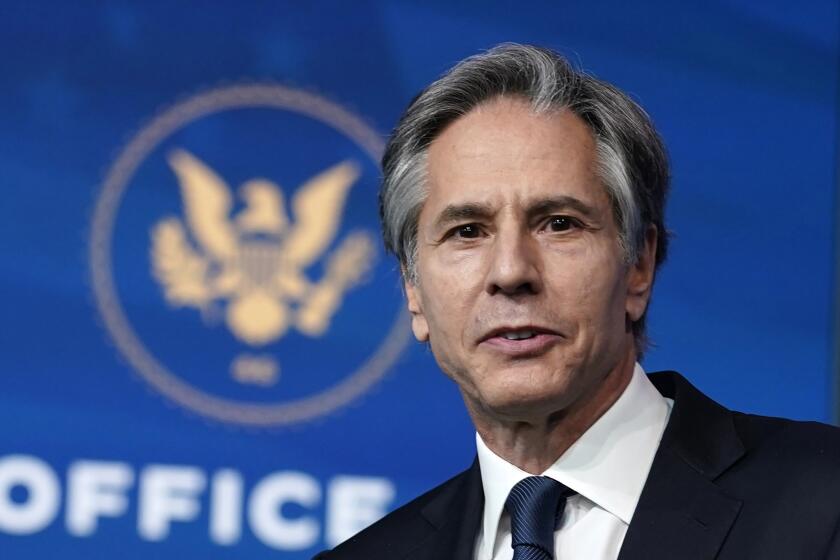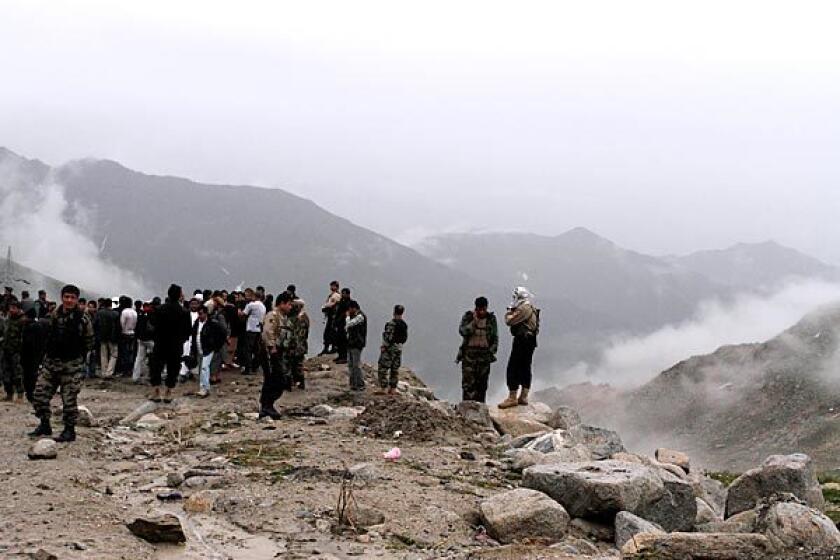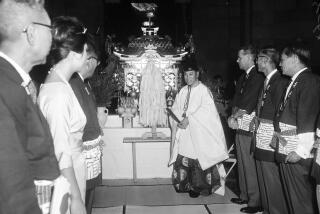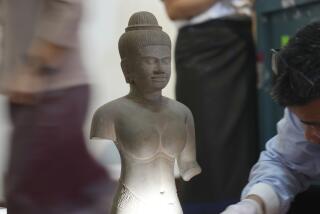Uncertain about its future, Afghanistan gets back smuggled relics from its past
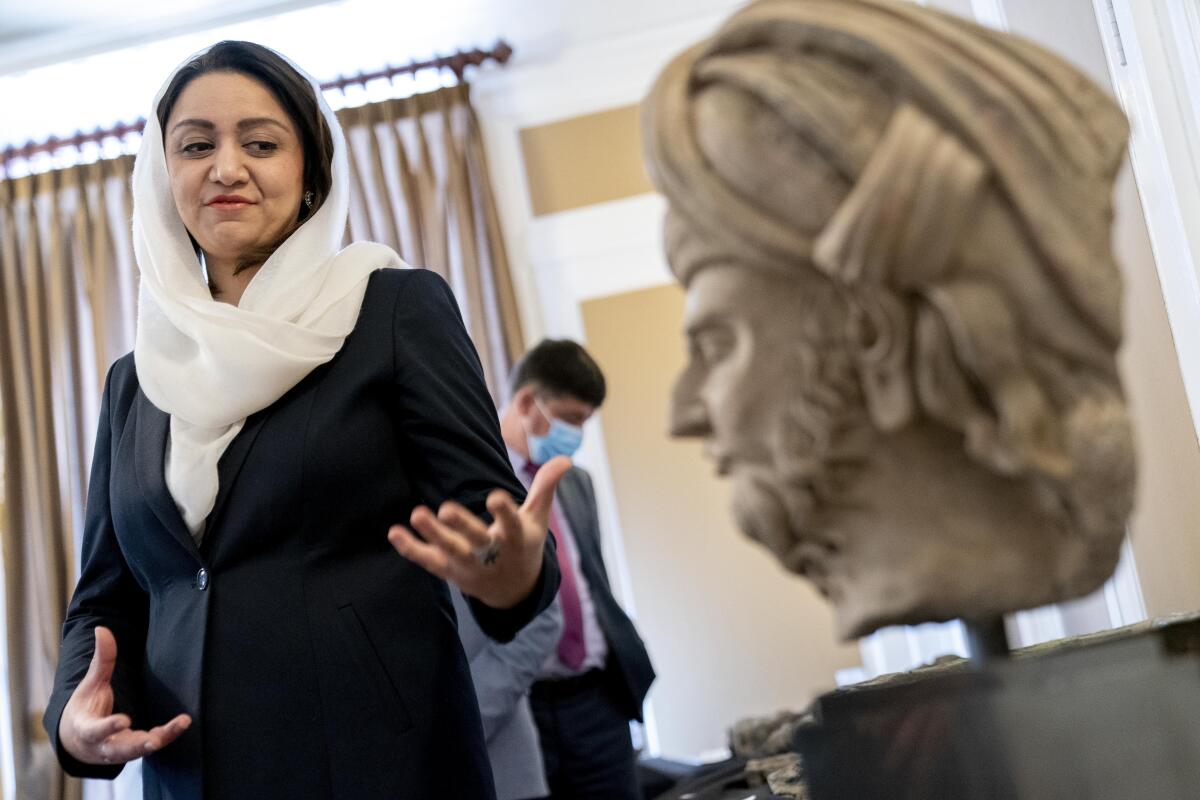
- Share via
WASHINGTON — Precious relics of Afghanistan’s ancient past are returning home even as the nation confronts deepening uncertainty about its future.
A collection of 33 artifacts seized from a New York-based art dealer who authorities say was one of the world’s most prolific smugglers of antiquities was turned over by the U.S. to the government of Afghanistan this week.
“The significance of the material is huge,” Roya Rahmani, the country’s ambassador to the U.S., said Wednesday. “Each one of these pieces are priceless depictions of our history.”
Rahmani formally took control of the collection in a ceremony Monday in New York with the Manhattan district attorney’s office and Homeland Security Investigations, which recovered the artifacts as part of a larger investigation into the trafficking of antiquities from a number of countries.
Now, after briefly being displayed at the embassy in Washington, the masks, sculptures and other items, some from the 2nd and 3rd centuries, are en route to Kabul, where they are expected to go on display at the National Museum.
It’s the same museum where members of the Taliban destroyed artifacts in 2001 as part of a cultural rampage rooted in a fundamentalist version of Islam, in which depictions of the human form are considered offensive.
Young Afghans fear losing new freedoms and their lives to the Taliban as U.S. troops prepare to exit.
The Taliban is now out of power. But it controls much of the country outside of Kabul amid stalled talks with the government and the looming withdrawal of U.S. and NATO forces after two decades of war. Rahmani concedes it’s a delicate time.
“However, what I know is that our security forces are determined to defend our people,” she said in an interview with the Associated Press. “The government is committed to do its part for peace and stability in a way that would bring durable peace.”
President Biden has said the U.S. would remove all its troops by Sept. 11, the 20th anniversary of the attacks that prompted the American invasion to dislodge the Taliban in 2001 for allowing Al Qaeda to operate from Afghanistan.
Before the Sept. 11 attacks, the Taliban had already become internationally notorious for enforcing a harsh form of Islamic law that kept women out of public view and for destroying — with rockets, shells and dynamite — the famed giant, 6th century sandstone Buddha statues built into a cliff in Bamiyan province.
Secretary of State Antony Blinken makes an unannounced visit to Afghanistan to sell its leaders on President Biden’s plan to withdraw all U.S. troops.
Rahmani says she wept when she first learned what the Taliban had done to the Buddha statues.
By contrast, the recovered antiquities are “returning to a government and people who cherish their past” and will make sure they are preserved for future generations, Rahmani said. She doesn’t expect the Taliban, if they return to power, would dare to destroy them.
“Our security forces and our government would not let that happen,” she said. “We are determined not to let that happen.”
Like the statues, some of the recovered antiquities depict Buddha. There’s also a marble statue of the Hindu god Shiva and a Greek mask. The artifacts reflect the multicultural influences on Afghanistan, an important center of trade and commerce, according to Fredrik Hiebert, an archaeologist and National Geographic fellow who studies the country.
Men on the border between Afghanistan and Iran have battled for centuries. Now a fight over water is brewing.
There are at least 2,600 archaeological sites around the country, said Hiebert, who helped authenticate some of the items after they had been confiscated by federal agents.
“Afghanistan is one of the richest countries in archaeology and history in the world,” he said. “And there’s very good reason, of course. For 6,000 years there’s been civilization based in Afghanistan.”
That also makes it an attractive target to looters, which is how the items eventually ended up in the United States.
In 2007, Homeland Security Investigations, an agency that deals with cases of smuggling that cross international borders, received information about looted artifacts brought to the New York area from India.
Breaking News
Get breaking news, investigations, analysis and more signature journalism from the Los Angeles Times in your inbox.
You may occasionally receive promotional content from the Los Angeles Times.
It eventually led to the indictment of a New York art gallery owner, Subhash Kapoor, and seven others, as well as the seizure of more than 2,600 artifacts, valued at more than $140 million. Kapoor is in jail in India and faces extradition to the U.S.
In the meantime, the U.S. government is working to repatriate the looted material, much of which was found in a series of raids on storage units in the New York area.
They have already returned relics to Nepal and Sri Lanka and soon will turn over artifacts to Thailand, said Stephen Lee, the supervisor special agent in charge of Homeland Security Investigations’ cultural property, arts and antiquities unit. The 33 items being sent to Afghanistan, valued at around $1.8 million, are the first to go back there as part of this investigation.
“They belong to the people of Afghanistan,” Lee said. “That’s their cultural history.”
More to Read
Sign up for Essential California
The most important California stories and recommendations in your inbox every morning.
You may occasionally receive promotional content from the Los Angeles Times.

